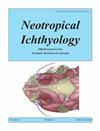追踪巴西Lebiasina物种(Teleostei: Lebiasinidae)的进化途径:染色体和基因组的比较研究
IF 2
4区 生物学
Q1 ZOOLOGY
引用次数: 2
摘要
尽管在小型鱼类的染色体分析中存在一些困难,但在过去的几年中,Lebiasinidae的细胞遗传学得到了很大的改善,显示了该家族内部染色体进化的不同模式。在这种情况下,已经证明Lebiasina属保留其核型宏观结构,由2n = 36条染色体组成,而其他属通常呈现更高的2n。本文采用常规方法和分子方法对三种白莲属植物进行了细胞遗传学比较,其中一种为首次分析。这些结果强化了Lebiasina属的分化进化路径,同时强调了每个物种进化过程中的基因组特殊性。从这个意义上说,基因组的重复成分在每个物种的分化中发挥了重要作用。同样值得注意的是,L. minuta和L. melanoguttata这两个只出现在巴西领土上的物种,比跨安第斯山脉的姐妹物种L. bimaculata表现出更大的染色体相似性。本文章由计算机程序翻译,如有差异,请以英文原文为准。
Tracking the evolutionary pathways among Brazilian Lebiasina species (Teleostei: Lebiasinidae): a chromosomal and genomic comparative investigation
Abstract Despite several difficulties in chromosomal analyses of small-sized fishes, the cytogenetics of the Lebiasinidae was largely improved in the last years, showing differential patterns in the chromosomal evolution inside the family. In this context, it has been shown that genus Lebiasina preserves its karyotypic macrostructure, composed of 2n = 36 chromosomes, whereas the other genera generally present higher 2n. This study focused on the comparative cytogenetics of three Lebiasina species, one of them analyzed here for the first time, using conventional and molecular procedures. The results reinforced the differentiated evolutionary path of the genus Lebiasina while, at the same time, highlighted the genomic particularities that have accompanied the evolution of each species. In this sense, the repetitive components of the genome played a significant role in the differentiation of each species. It is also notable that L. minuta and L. melanoguttata, the two species that occur exclusively in the Brazilian territory, show greater chromosomal similarities to each other than to the trans-Andean sister species, L. bimaculata.
求助全文
通过发布文献求助,成功后即可免费获取论文全文。
去求助
来源期刊

Neotropical Ichthyology
生物-动物学
CiteScore
2.80
自引率
17.60%
发文量
24
审稿时长
6-12 weeks
期刊介绍:
Neotropical Ichthyology is the official journal of the Sociedade Brasileira de Ictiologia (SBI). It is an international peer-reviewed Open Access periodical that publishes original articles and reviews exclusively on Neotropical freshwater and marine fishes and constitutes an International Forum to disclose and discuss results of original research on the diversity of marine, estuarine and freshwater Neotropical fishes.
-Frequency: Four issues per year published only online since 2020, using the ‘rolling pass’ system, which posts articles online immediately as soon as they are ready for publication. A searchable and citable Digital Object Identifier (DOI) is assigned to each article immediately after online publication, with no need to await the issue’s closing.
-Areas of interest: Biology, Biochemistry and Physiology, Ecology, Ethology, Genetics and Molecular Biology, Systematics.
-Peer review process: The Editor-in-Chief screens each manuscript submitted to Neotropical Ichthyology to verify whether it is within the journal’s scope and policy, presents original research and follows the journal’s guidelines. After passing through the initial screening, articles are assigned to a Section Editor, who then assigns an Associate Editor to start the single blind review process.
 求助内容:
求助内容: 应助结果提醒方式:
应助结果提醒方式:


